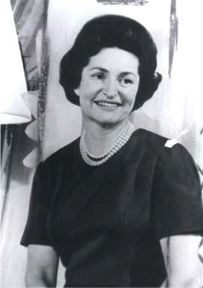Lady Bird Johnson Juvenile/Educational Biography

Claudia Alta (Lady Bird) Taylor Johnson
(December 22, 1912- July 11, 2007 )
When Lady Bird Johnson was born, her nursemaid proclaimed her “as pretty as a ladybird.” The nickname stuck. Her real name, Claudia Alta Taylor, is all but unknown. She was the youngest of 3 children born to Thomas Jefferson (T.J.) Taylor and his wife Minnie Patillo Taylor, and the only daughter. Her mother died when Lady Bird was 5; her maiden aunt, Effie Patillo helped raise her.
Lady Bird was an excellent student who graduated 3rd in her class at MarshallHigh School. She attended St. Mary’s Junior College for Girls and then transferred to the University of Texas. She graduated with a Bachelor of Arts degree in 1933 with a major in journalism. In addition, she was granted a teaching certificate.
The next year, while visiting a family friend, she was introduced to young Lyndon Baines Johnson, congressional aide to Congressman Dick Kleberg. Smitten, Lyndon asked her to join him for breakfast the next morning. Although she did not reply, she appeared the next morning. That commenced a whirlwind courtship; he proposed that afternoon and they were married 2 months later on November 17, 1934, in St. Mark’s Episcopal Church in San Antonio, Texas.
The young couple settled in Washington, DC. Lyndon ran for Congress in 1937, armed with a $10,000 loan from Lady Bird. After his win, she helped Lyndon in his office, conducted sightseeing tours for constituents when they came to the nation’s capitol, and learned the names of all the politicians and counties in his district. When Lyndon served in the armed forces during World War II, Lady Bird acted as a liaison between Lyndon and his district. She also bought the radio station KTBC and made it a success. When Lyndon ran for the Senate, Lady Bird overcame her innate shyness and learned to give speeches, canvass votes, and make phone calls seeking support for him, all the while caring for their two young daughters, Lynda Bird and Luci Baines. After his election to the Vice Presidency, the family moved into their own house on 52nd Street in Washington, called “The Elms.” They also bought their beloved ranch on the PedernalesRiver in Texas. Lyndon’s heart attack in 1955 made Lady Bird cautious about his health and she frequently urged him to take it easier. However, when John Kennedy tapped Lyndon for his vice presidential running mate in 1960, Lady Bird whole-heartedly supported her husband. She was such an effective and energetic campaigner that the Kennedy election committee nicknamed her “Secret Weapon.”
January of 1961 found Lady Bird on the Inaugural grandstand while Lyndon took the oath of office for the vice presidency. She had three main goals: help her husband, assist First Lady Jacqueline Kennedy, and continue to grow and learn. Lady Bird traveled extensively for the administration, logging over 120,000 miles and visiting 30 countries. On November 22, 1963, she too was in Dallas when President Kennedy was assassinated. Photographs of Lyndon taking the oath of office for the Presidency show Mrs. Kennedy on the right and Lady Bird on the left.
The nation was still stunned from the assassination when the Johnson’s finally moved into the White House. Lady Bird was aware that she could not compete with the glamour of Jacqueline Kennedy and did not attempt it. Instead, she sought causes to which she could give her name and her energies. She made headlines during the 1964 campaign when she became the first First Lady to go on a campaign trip for her husband by herself. She styled the tour train “The Lady Bird Special,” and she made 47 stops and covered over 1600 miles. Three days later, when the tour ended in New Orleans, Lyndon joyfully met her at the train station. The “Secret Weapon” had all but defused much of the anger felt by Southerners toward Lyndon’s Great Society legislation.
After a landslide win, Lady Bird felt she was First Lady in her own right. She organized the First Lady’s Committee for a More Beautiful Capitol and the White House Conference on Natural Beauty. Following along the same lines, the Highway Beautification Bill of 1965 was often called the “Lady Bird Bill” since its purpose was to address the problems of litter, tasteless billboards, and dumps along America’s roadways. She also worked tireless for the development of Project Head Start, a program for pre-schoolers whose families do not have financial access to educational resources.
However, Lyndon became increasingly despondent about the Vietnam War. He and Lady Bird had already written a portion of a speech in which he would announce his decision not to seek reelection in 1968. Therefore, she was not surprised during a press conference in March of that year when he concluded his remarks with the paragraphs they had written together. In January of 1969, they retired to their ranch in Texas where Lyndon died only 4 years later. Lady Bird devoted her time and energies to the LBJ Presidential Library and to the creation of the NationalWildlifeResearchCenter. She also campaigned for her son-in-law, Charles Robb, who had married her daughter Lynda, in his campaign for Governor of Virginia and then later in his campaign for Senator. Her own health, especially a series of small strokes, limited her activities in years.
She died on July 11, 2007 and is buried beside her husband at the Ranch near Stonewall, Texas.
|